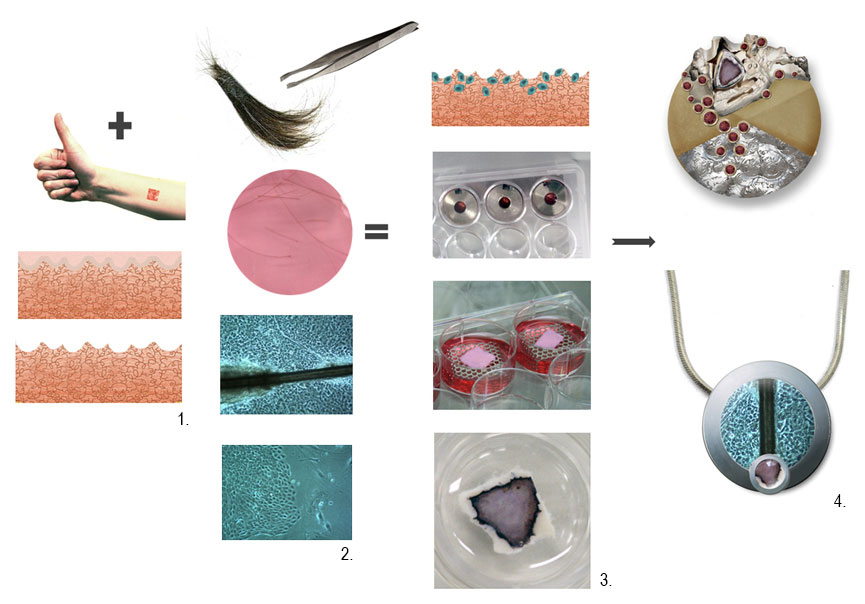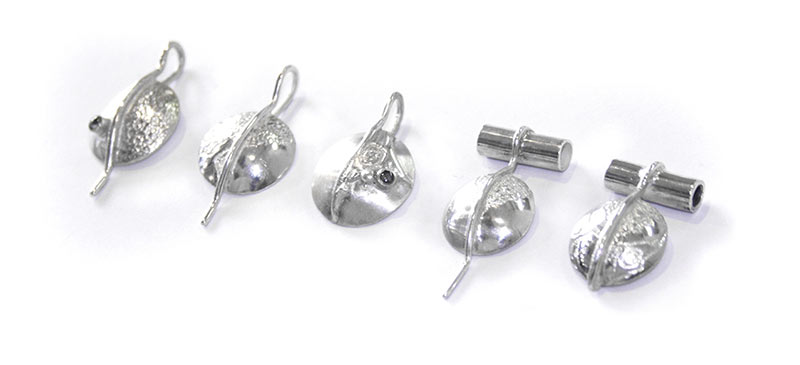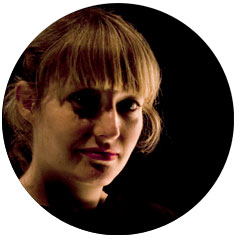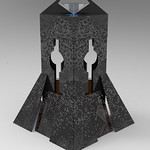THE HSE PROJECT
OVERVIEW
The Human Skin Equivalent/Experience Project forms part of an ongoing exploration of the critical and creative potentials of biotechnology in contemporary arts practice. Developed in a creative partnership with the Tissue Repair and Regeneration (TRR) Group at the Queensland University of Technology’s Institute of Health and Biomedical Innovation (IHBI), the project involves the development of skin jewellery – personal jewellery items incorporating 3D Human Skin Equivalent (HSE) models created from a scaffold of skin grafts of the artist seeded with skin cells from project participants.
The project was devised in an effort to develop a creative project that could complement the research of IHBI TRR researchers who are primarily involved in “devising and developing innovative and improved technologies and therapeutic approaches for the management of tissues degraded through trauma, normal ageing processes, wear and tear, ageing related disease and/or associated surgery” (Queensland University of Technology, 2009), with a particular focus on wound healing and tissue repair. As part of this research objective, the TRR group developed multi-component 3D Human Skin Equivalent (HSE) models. These HSEs have been created as an alternative to animals models in wound healing research and are composed of a de-epidermised dermal (DED) layer of skin seeded with keratinocytes (skin cells), all derived from the surgical off cuts of consenting patients undergoing plastic surgery.
Using the same basic principles, The HSE Project involved the production of HSEs composed of DEDs from surgically removed sections of the artist’s skin, seeded with keratinocytes isolated from the hair follicles of project participants. Once completed, these HSEs were preserved and incorporated into a personal jewellery piece designed in conjunction with each participant.
PROCESS

1. Surgical removal of skin sections and creation of de-epidermised dermis DED as a dermal scaffold for HSE development.
2. Plucking of participant hair follicles and isolation/culturing of skin cells (keratinocytes).
3. Seeding participant skin cells on prepared DED, development of HSE and later staining to show metabolically active cells.
4. Fixation of HSE model and inclusion in personal jewellery item designed in collaboration with participants and the artist.
DETAILS
Three participants from different backgrounds were selected to take part in the project. These participants, rather than being donors alone, had the opportunity to take a more active role in project development and are were invited to take part in basic procedures such as changing the nutrient media (feeding their cells).
Conceptually the creation of skin jewellery, which is commonly perceived as an abject and somewhat disturbing practice, aimed to tap into cultural and social taboos surrounding the body and use of body derived ‘products’, such as cells and tissues. The project also follows on from early concerns of working with cell lines in which the original donor may be unaware of their establishment and application. In this instance, participants were able to consent to the procedure and provide critical comments and insights into the use of their cells. Creating jewellery items which, have since become the property of the participant, also enables the artworks to be worn, and thus exhibited through everyday social interactions, facilitating further discussions related to the body and cell and tissue culture technologies.
Jewellery items produced during the project include a pendant brooch, set of earrings and removable drops incorporating HSE sections in resin and two rings with engravings of the participant’s cells.

1. Participant #1: Pendant Brooch
2. Participant #2: Rings
3. Participant #3: Earrings with matching drops.
The artist created an additional pendant as part of the project that incorporated carbon particles of captured wound scent and sections of a HSE created with the artist’s DED and skin cells.

1. Carbon sorbent tube used to capture wound scent.
2. Impinger set up.
3. Jewellery item with carbon particles, HSE and bandages.
Each member of the Skin Group also received a jewellery item to commemorate the project.

In addition to the conceptual basis of the project, the creation of HSEs that use hair follicle derived keratinocytes has helped optimise a protocol for cell isolation from human hair follicles and tested the feasibility of growing HSEs in animal product-free conditions (in response to one of the participants who follows a Vegan lifestyle).
PROJECT PARTNERS
The HSE Project was developed in a creative partnership with IHBI and the TRR Skin Group. Special thanks are extended to Professor Zee Upton, Rebecca Dawson, Dr Jacqui McGovern, Dr Tara Fernandez, Annette Spierings and Skin Group members. Many thanks also to the amazing surgeon for volunteering his time and project participants for their enthusiasm and support during all stages of project development. Thank you also to Ewald and Liz Kratz of Kratz Exclusive Jewellery for assistance with the production of the jewellery items.








